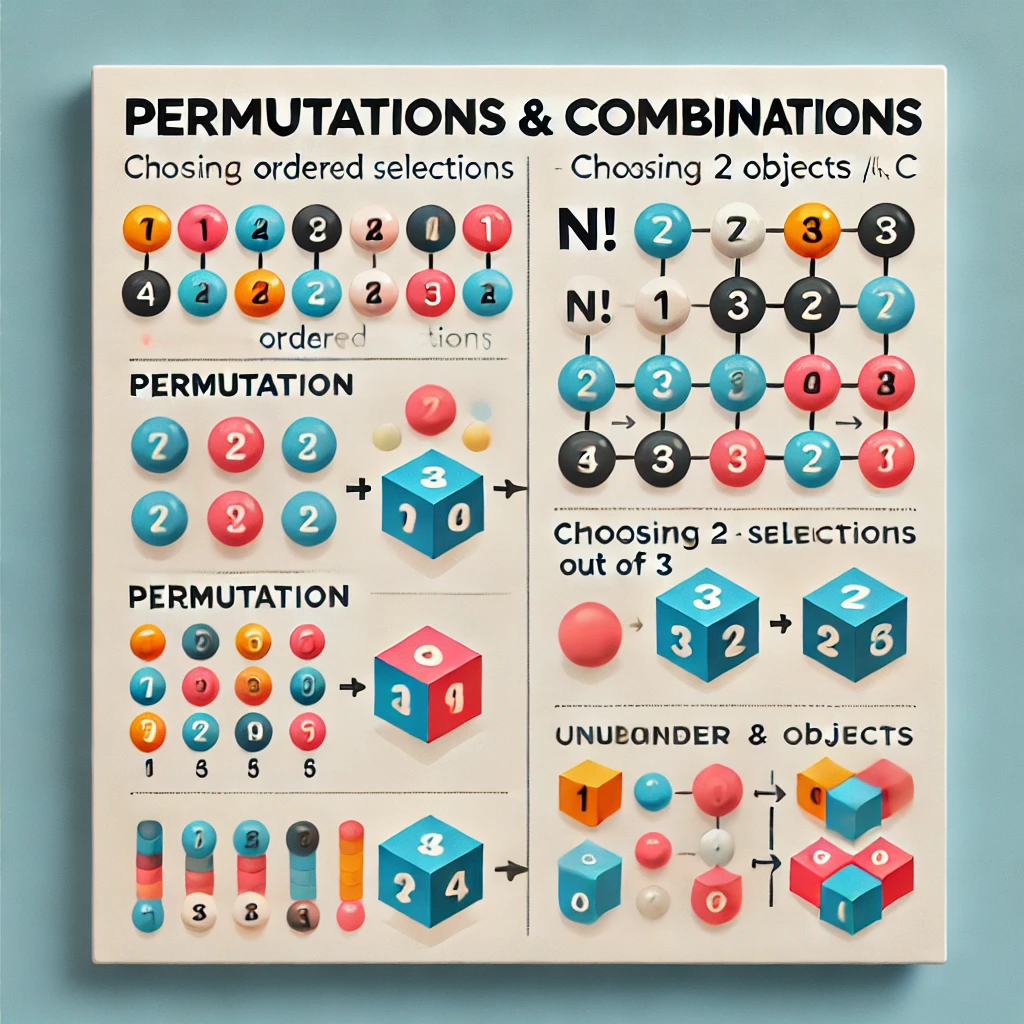Introduction to Permutations and Combinations
Permutations and combinations are fundamental concepts in the field of mathematics, particularly in the area of combinatorics. They provide essential tools for counting and arranging objects in various contexts. Although they are often discussed together, they serve distinctly different purposes and rely on varying principles. Understanding the difference between these two concepts is crucial for solving a range of mathematical problems.
Permutations refer to the different ways in which a set of objects can be arranged or ordered. Specifically, when the order of selection is significant, the arrangement of the objects matters. For instance, if we consider three letters: A, B, and C, the permutations of these letters would include arrangements such as ABC, ACB, BAC, BCA, CAB, and CBA. The total number of permutations can be calculated using the formula n!, where n represents the number of distinct objects. In our example with three letters, the total permutations would be 3! = 6.
On the other hand, combinations refer to the selection of objects where the order does not matter. When considering combinations, we are interested in how many ways we can select a group of items without regard to the arrangement. Taking the same example of A, B, and C, the combinations of selecting two letters would yield the sets AB, AC, and BC. Here, the order is irrelevant; AB is considered the same as BA. The formula for calculating combinations is given by n! / [r!(n-r)!], where n is the total number of objects, and r is the number of objects to choose.
Understanding permutations and combinations has practical applications in various fields, including probability, statistics, and operational research. By grasping these concepts, individuals can enhance their ability to analyze situations that involve arrangement and selection systematically.
Permutations: Order Matters
Permutations are arrangements of items where the order of selection is crucial. When we discuss permutations, we delve into scenarios where the sequence of the chosen elements greatly affects the overall outcome. The formula for calculating permutations is given by n!, where n represents the total number of items, and r denotes the number of selections made. The specific permutation formula can be expressed as P(n, r) = n! / (n – r)!, highlighting how the order can change outcomes significantly.
For example, consider the arrangement of three letters: A, B, and C. The possible permutations include ABC, ACB, BAC, BCA, CAB, and CBA—showcasing a total of six distinct orders. This illustrates that when we vary the placement of the same set of elements, we create multiple unique outcomes. It is essential to note that permutations are particularly relevant in situations such as creating passwords or generating seating arrangements, where the sequence of characters or people matters immensely.
Common misconceptions about permutations often confuse them with combinations, where order does not factor into the arrangement. For instance, choosing two fruits from a set of apples and oranges could yield the pairs (apple, orange) and (orange, apple) as distinct permutations, while in combinations, they would simply count as one selection. Practically, understanding permutations has applications in various fields including data arrangement, scheduling tasks, and organizing events, where the correct sequence plays a vital role in the effectiveness of the outcome.

Combinations: Order Doesn’t Matter
Combinations are a fundamental concept in the field of combinatorics, specifically used in scenarios where the order of selection is irrelevant. Unlike permutations, which consider different arrangements as distinct outcomes, combinations focus solely on the grouping of items. This distinction is crucial in various applications, including statistics, probability, and real-world decision-making processes.
The mathematical representation of combinations is given by the formula C(n, r) = n! / [r!(n – r)!], where C(n, r) denotes the number of combinations possible, n represents the total number of items to choose from, r is the number of items to be chosen, and ! signifies factorial, meaning the product of all positive integers up to that number. This formula helps calculate the number of ways to select r items from a set of n items without considering the arrangement.
To illustrate, consider a simple example: Suppose a committee is to be formed from a group of five individuals, labeled A, B, C, D, and E. If the committee consists of three members, the possible combinations would include ABC, ABD, ABE, ACD, ACE, ADE, BCD, BCE, BDE, and CDE. Notably, combinations such as ABC and ACB are considered the same because the order of selection is not significant.
In the real world, combinations are frequently applied in various contexts, such as lottery games, where players choose a set of numbers without regard to the sequence in which they are drawn. Another key application lies in team formations in sports, where coaches select players based on capabilities rather than the order in which they are picked. Additionally, in research, when selecting a sample for study, it is critical to use combinations to ensure that the selection reflects the population’s diversity without imposing a specific order. These practical examples highlight the importance of understanding combinations in everyday life.
Practical Applications and Examples
Permutations and combinations play a critical role in various domains, lending themselves to diverse applications that span marketing strategies, probability theory, and computer science. Understanding how to apply these concepts can enhance decision-making processes in numerous fields.
In marketing, for instance, companies often use combinations to determine potential customer segments. By analyzing different groups based on demographics or purchasing behaviors, marketers can leverage combinations to create targeted campaigns. For example, if a brand wishes to reach specific audiences such as young adults, seniors, and families, combinations allow them to explore different marketing strategies tailored to these segments. Through this process, businesses can optimize their advertising efforts, ensuring higher engagement and conversion rates.
In the field of probability theory, permutations and combinations facilitate the calculation of outcomes in uncertain scenarios. Consider a card game where players need to arrange cards in a certain sequence. The total number of ways to organize these cards is derived from permutations, as the order matters. Similarly, when selecting a subset of cards without regard to order, combinations are employed to derive the number of possible hands a player might hold. Thus, mastering these concepts enables individuals to make more informed predictions about likely outcomes in games of chance.
In computer science, permutations and combinations are essential for algorithm design, particularly in scenarios involving data organization and search optimization. For example, generating all potential combinations of a user’s preferences helps customize software recommendations effectively. Additionally, cryptography often utilizes permutations to ensure data security by encoding messages in unique sequences, making it challenging for unauthorized parties to decode the information.
Conclusion
Engaging with real-world problems that require the application of permutations and combinations deepens one’s understanding. For instance, one can calculate the number of different ways to arrange a group of friends for a photo or devise a unique code name using a combination of chosen letters. These exercises not only reinforce theoretical knowledge but also foster critical thinking skills, illustrating the practicality of these mathematical concepts in everyday life.
Read our Latest Blog
Matrices and Determinants Made Easy for Class 12 Students
Phone Number: +91-7488456170
Email ID: abhishek@eepl.me
Our Platforms:
Digilearn Cloud
EEPL Test
Live Emancipation
Follow Us on Social Media:
Instagram – EEPL Classroom
Facebook – EEPL Classroom
Stay connected and keep learning with EEPL Classroom !









